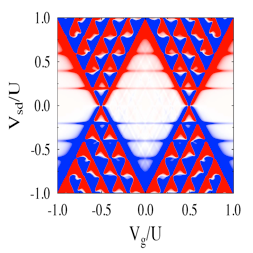Inelastic effects in molecular junctions

One of distinct features of molecules (compared for instance to semiconductor quantum dots) is their flexibility, so that inelastic effects in transport through molecular devices are more pronounced.
Currently inelastic quantum transport through tunneling junctions at resonance can be treated properly only in the weak electron-vibration coupling (when coupling to contacts is much stronger than interactions on the bridge). The other extreme is usually treated either within semi-classical (master equation) approaches or is based on scattering theory considerations. In the last case electron-vibration coupling can be taken into account exactly (or numerically exactly), but all junction related information (Fermi seas in the contacts and their influence on the bridge processes) is lost.
We develop theoretical techniques to improve quality of calculations in the strongly correlated regime. The latter is of particular importance for practical applications (molecular switches, memory, and optoelectronic devices).
